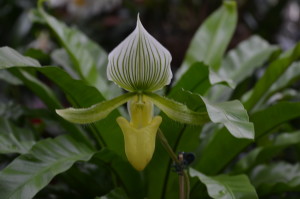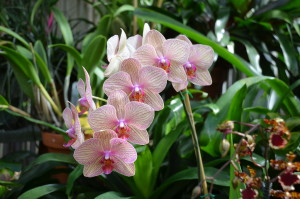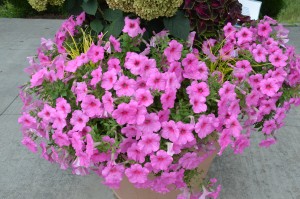At one time growing orchids was an elitist hobby for the very rich in our society. Orchids were expensive to purchase. Today, local greenhouses and garden centers sell orchids at affordable prices. Moth (Phalaenopsis) and lady slipper orchids (Paphiopedilum) are the simplest to grow. Here are some easy tips to make home orchid growing a rewarding year-round hobby.
Many orchid species are difficult to grow inside modern homes; not so for the moth and lady slipper orchids. In their natural habitat, orchids are plant epiphytes which grow on tree trunks and branches in the humid tropics. Their thick fleshy roots draw moisture from the air and various surfaces around the roots.
Most important, in northern temperate regions, orchids may spend most of the spring and summer months outdoors beneath the dense leafy canopy of a shade tree in your landscape. In early fall before cold night temperatures arrive (below 40 ºF), plants come back indoors. Orchids are comfortable in home temperatures between 60 and 80 °F.
Low room humidity between 10-40 % during the winter may challenge orchids. Bathrooms and the kitchen are the most humid rooms in a typical home. Group several plants together and set on a tray filled with moist pea gravel. Spray or mist plants daily in winter.
Across the Northern hemisphere outdoor light peering through windows in the winter months is generally lacking. Sunlight intensity is weak and day length is short between November through February. Moth and ladyslipper orchids need only bright light and not direct sunlight.
Orchids should be planted in special potting mix containing coarse bark, sphagnum peat moss and perlite. Some medias add charcoal to improve drainage and filter out impurities. A good orchid potting mix retains moisture only a few days. Otherwise, the fleshy orchid roots begin to rot if growing media stays too wet over many days. Never leave an orchid standing in water over many hours. Annually, repot your orchids after flowering, usually in the spring or in late summer.
Fertilize orchids “weakly” and “weekly” from spring thru fall with a high phosphorus-based soluble house plant fertilizer. Package directions for most house plant fertilizers are too strong for orchids. Use only half the recommended rate and feed weekly. Orchids are fertilized once monthly from December thru February. After repotting, do not fertilize for 2-3 weeks.























